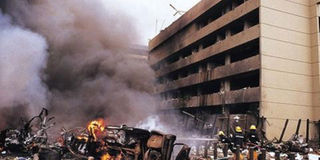How US embassies were bombed

Smoke billows from one of the cars that were packed with explosives used to bomb the US embassy in Nairobi. Net Photo
On August 7, 1998 at 10:30am local time, explosives packed on trucks were detonated outside the US Embassy in Nairobi, Kenya. Minutes later, another truck bomb detonated outside the US embassy in Dar es Salaam.
In retaliation, the US launched cruise missiles on August 20, 1998, striking a suspected terrorist training complex in Afghanistan and destroying a pharmaceutical manufacturing facility in Khartoum, Sudan, that reportedly produced nerve gas used to manufacture the bombs.
The US said both targets were believed to have been financed by wealthy Islamic radical Osama bin Laden, who was allegedly behind the embassy bombings as well as an international terrorism network targeting the United States.
In Nairobi, the US Embassy was located in a congested downtown area. The attack killed a total 291 persons and wounded about 5,000. The bombing in Dar es Salaam killed 10 persons and wounded 77.
Investigations have since revealed that the Nairobi attack was led by Ali Mohamed, a former Egyptian army officer who had in the mid-1980s joined the US army. He provided guidance and training to extremists. The terror cell’s ‘casing team’ in Nairobi also included a computer expert whose write-ups were reviewed by al-Qaeda leaders.
According to Global Security Organisation, a security information operation, the team set up a makeshift laboratory for developing their surveillance photographs in an apartment in Nairobi where various al-Qaeda operatives and leaders based in, or travelling to the Kenya cell, sometimes met.
Banshiri, al-Qaeda’s military committee chief, continued to be the operational commander of the cell but because he was constantly on the move, Osama bin Laden had dispatched another operative, Khaled al Fawwaz, to serve as the on-site manager.
The technical surveillance and communications equipment employed for these casing missions included state-of-the-art video cameras obtained from China and from dealers in Germany. The casing team also reconnoitred targets in Djibouti, sources say.
By August 1, members of the cells not directly involved in the attacks had mostly departed from East Africa. The remaining operatives prepared and assembled the bombs, and acquired the delivery vehicles. On August 4, they made one last casing dry run at the US embassy in Nairobi.
By the evening of August 6, all but the delivery teams and one or two persons assigned to remove the evidence trail had left East Africa.
Back in Afghanistan, Bin Laden and the al-Qaeda leadership already facing an intense US-led NATO onslaught had fled Kandahar for the countryside, expecting US retaliation.
Declarations taking credit for the East African attacks had been faxed in advance to the joint al-Qaeda-Egyptian Islamic Jihad office in Baku, with instructions to standby for orders to “instantly” transmit them to Al Quds al Arabi.
As early as January 1994, Bin Laden had received the surveillance reports, complete with diagrams prepared by the team’s computer specialist. Agreeing that the US embassy in Nairobi was an easy target because a car bomb could be parked close by, they began to form a plan.


